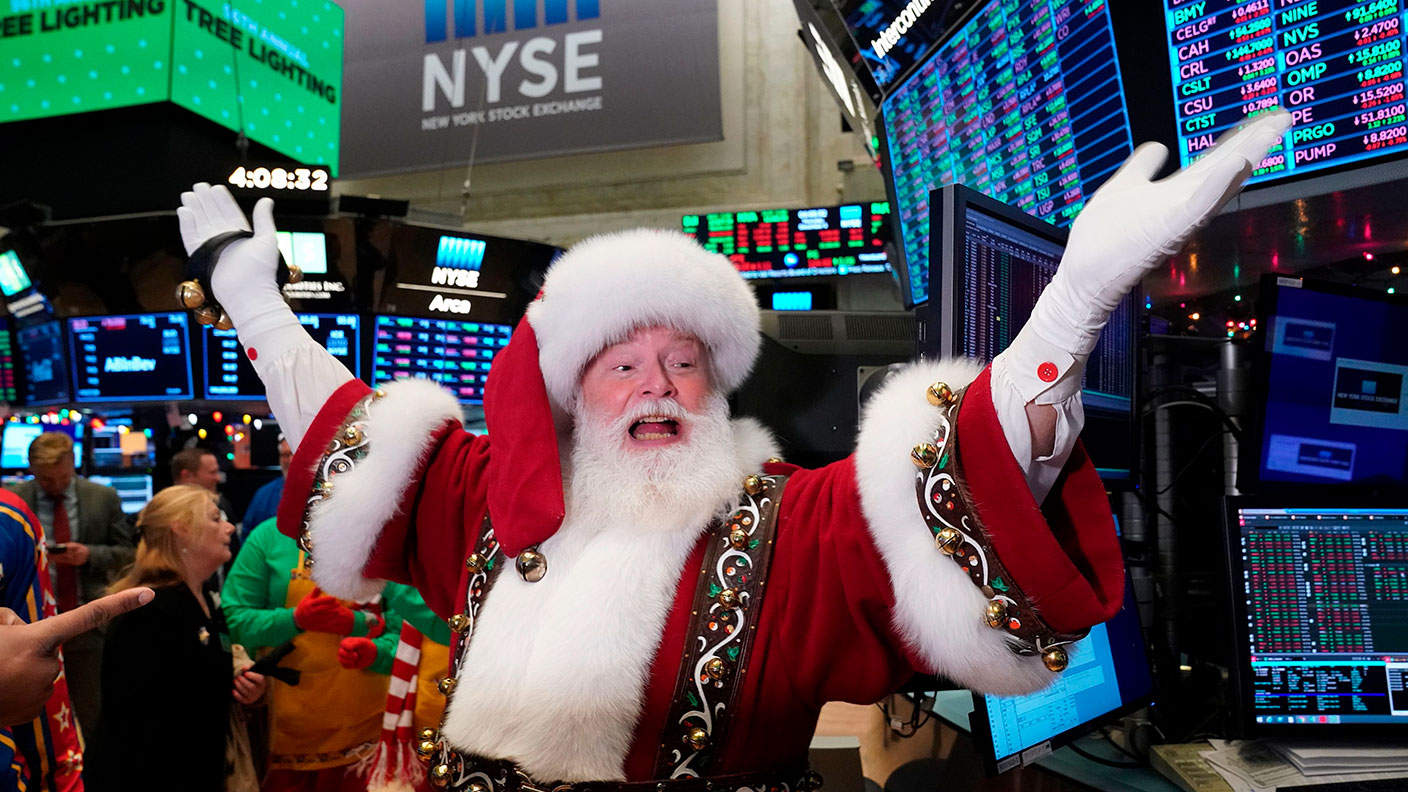What can the “January barometer” tell us about 2022 stockmarket prospects?
How the stockmarket performs in the first month of the year can often have a bearing on its performance for the remainder. Max King looks at what it’s telling us about its prospects for 2022.

The “January barometer” has been a staple, if declining, investment topic for pundits and journalists for the last 50 years.
This is the hypothesis that, as January goes on Wall Street, so goes the year. It has a strong record of success – at least 75% (depending on the time frame chosen) with few serious errors.
This gives rise to two further related hypotheses: “the Santa Claus rally” and the “January early warning indicator.” The first argues that a rising market over the Christmas period is bullish for the next year; the second that the first five trading days of January are a good indicator of how January and hence the year would turn out.
MoneyWeek
Subscribe to MoneyWeek today and get your first six magazine issues absolutely FREE

Sign up to Money Morning
Don't miss the latest investment and personal finances news, market analysis, plus money-saving tips with our free twice-daily newsletter
Don't miss the latest investment and personal finances news, market analysis, plus money-saving tips with our free twice-daily newsletter
On the basis of these two hypotheses, investors can look forward to a good 2022 in the UK and Europe, but not necessarily in the US.
However, there are caveats.
The logic behind the January barometer
The January barometer has worked less well recently than in earlier decades. There used to be an argument that the success of the indicator was related to the political cycle – something to do with when the US Congress started a new sitting, which changed many years ago. But it has certainly proved erratic in recent years.
In 2018, the S&P 500 rose 6% in January but lost 6% for the year. In 2020, the 1% loss in January was a good warning of the pandemic-related melt-down in March, but not of the 18% return for the year as a whole. Most of the barometer’s errors have been in the latter direction; poor Januaries giving a false signal for the year as profit-taking after a good prior year temporarily held the market back.
Much of the record of the hypothesis is accounted for by simple maths. A good January gives an upward bias to annual returns but returns after January aren’t usually as good as for the whole year. For example, 1987 started strongly, but the October crash and modest subsequent recovery meant that February to year-end returns were negative even though they were positive for the whole year.
The long-term uptrend of Wall Street means that it rises in three years out of four while its tendency to rise slowly but drop sharply means that most months are up-months. So it’s not surprising that up-Januaries correlate with up-years. Recognition of these factors and the increased number of false signals have discredited the January barometer.
Still, there may be some residual logic to January being a good indicator for the year as a whole. The financial year for most companies is the same as the calendar year and most investors attach more weight to a year that has started, even if only just, than one that hasn’t.
On 1 January, estimates of “next year’s earnings” become “this year’s”, encouraging the illusion that the shares have become cheaper, especially as the new “next year” appears more visible.
For the market as a whole, strategists work in calendar years, so 2021 now represents “historic” earnings and 2022 “this year’s” earnings. Next year moves to 2023, but nobody takes seriously forecasts for the year after next. The lower multiples for next year, assuming earnings are rising, put better valuations in touching distance.
Finally, most professional fund managers think in calendar years when it comes to their performance and hence remuneration. The new year means restarting the clock and a rising market nearly always rewards better than a falling one. Everybody wants to get the new year off to a good start.
One indicator will be a lot more important for 2022 than January’s stockmarket returns
What does that mean for 2022? A couple of other factors may help markets. Ed Yardeni says that he is taking “the alternative contrarian bet that inflation is peaking and will turn out to be transitory after all.”
He also argues that “the rapidly spreading Omicron variant could mark the end of the pandemic. Investors certainly seem to think so.” This could – despite the most recent stumbles in the US – still mean a positive start to 2022 though not necessarily strength throughout the year.
Firstly, if the good news is loaded into share prices at the start of the year, investors may find that strong earnings growth is already discounted in valuations. Markets often run out of steam two years into a recovery.
Secondly, energy prices could ratchet higher, giving new impetus to inflation and transferring wealth from productive to unproductive (or worse) economies with a consequent increase in political instability.
Charles Gave of Gavekal points out that structural bear markets are nearly always accompanied by accelerating inflation and rising energy costs, the only hiding place being in energy producers (for more on this, listen to the latest MoneyWeek podcast). In short, this year it’ll be worth paying a lot more attention to the oil and gas price barometer than the January barometer.
Get the latest financial news, insights and expert analysis from our award-winning MoneyWeek team, to help you understand what really matters when it comes to your finances.

Max has an Economics degree from the University of Cambridge and is a chartered accountant. He worked at Investec Asset Management for 12 years, managing multi-asset funds investing in internally and externally managed funds, including investment trusts. This included a fund of investment trusts which grew to £120m+. Max has managed ten investment trusts (winning many awards) and sat on the boards of three trusts – two directorships are still active.
After 39 years in financial services, including 30 as a professional fund manager, Max took semi-retirement in 2017. Max has been a MoneyWeek columnist since 2016 writing about investment funds and more generally on markets online, plus occasional opinion pieces. He also writes for the Investment Trust Handbook each year and has contributed to The Daily Telegraph and other publications. See here for details of current investments held by Max.
-
 Top 10 locations for buyers and renters revealed
Top 10 locations for buyers and renters revealedLondon is crowned as the most popular location for renters and buyers, despite rising costs. But where else are house hunters heading to?
-
 Making financial gifts to loved ones? Write it down or risk giving an IHT bill too
Making financial gifts to loved ones? Write it down or risk giving an IHT bill tooGiving gifts can be a way to pass on wealth and reduce the inheritance tax bill on your estate but do it wrong and you could leave family and friends more than they bargained for.
-
 Halifax: House price slump continues as prices slide for the sixth consecutive month
Halifax: House price slump continues as prices slide for the sixth consecutive monthUK house prices fell again in September as buyers returned, but the slowdown was not as fast as anticipated, latest Halifax data shows. Where are house prices falling the most?
-
 Rents hit a record high - but is the opportunity for buy-to-let investors still strong?
Rents hit a record high - but is the opportunity for buy-to-let investors still strong?UK rent prices have hit a record high with the average hitting over £1,200 a month says Rightmove. Are there still opportunities in buy-to-let?
-
 Pension savers turn to gold investments
Pension savers turn to gold investmentsInvestors are racing to buy gold to protect their pensions from a stock market correction and high inflation, experts say
-
 Where to find the best returns from student accommodation
Where to find the best returns from student accommodationStudent accommodation can be a lucrative investment if you know where to look.
-
 The world’s best bargain stocks
The world’s best bargain stocksSearching for bargain stocks with Alec Cutler of the Orbis Global Balanced Fund, who tells Andrew Van Sickle which sectors are being overlooked.
-
 Revealed: the cheapest cities to own a home in Britain
Revealed: the cheapest cities to own a home in BritainNew research reveals the cheapest cities to own a home, taking account of mortgage payments, utility bills and council tax
-
 UK recession: How to protect your portfolio
UK recession: How to protect your portfolioAs the UK recession is confirmed, we look at ways to protect your wealth.
-
 Buy-to-let returns fall 59% amid higher mortgage rates
Buy-to-let returns fall 59% amid higher mortgage ratesBuy-to-let returns are slumping as the cost of borrowing spirals.
